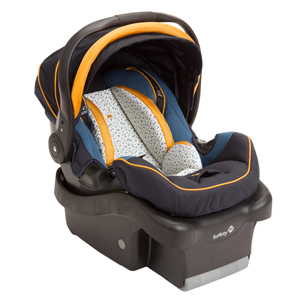
The humble child car seat might appear to be just a plastic shell with some padding and straps, but beneath this unassuming exterior lies a fascinating world of engineering, materials science, and even sociological influence.
These specialized safety devices represent a curious intersection of physics, psychology, regulatory science, and design thinking that deserves closer examination. From crash-test innovation to unexpected sustainability practices, today’s child car seats are how we protect our most vulnerable passengers.
The Unexpected Physics of Protection
Child car seats operate on biomechanical principles that differ significantly from adult restraint systems. While adult seatbelts primarily manage deceleration forces through the strongest parts of the skeleton (pelvis and chest), children’s developing bodies require completely different force management strategies.
The most advanced child seats function through controlled deformation—purposely engineered crumple zones within the seat itself that absorb crash energy before it reaches the child. This seemingly contradictory approach (allowing parts of the safety device to fail strategically) has revolutionized protection capabilities.
More fascinating is the specialized foam technology borrowed from aerospace applications. Many premium car seats now incorporate multi-density foams that respond differently based on impact speed—remaining soft during minor bumps but instantly hardening during high-energy crashes through non-Newtonian properties. These materials create an adaptive cushioning system that, unlike traditional foams, becomes more protective precisely when needed most.
The Unexpected Testing Revolution
The evolution of child car seat testing reveals how our understanding of crash dynamics has transformed. Early testing focused simply on whether a child remained inside the seat during a collision. Modern testing utilizes sensors recording 300+ data points per millisecond to map how crash forces travel through the seat structure and into the test dummy.
What many don’t realize is that child-specific crash test dummies represent remarkable feats of engineering. The most advanced models contain flexible spines with anatomically correct vertebrae, skull sensors that measure rotational forces linked to brain injuries, and specialized abdominal sensors that detect submarining—a dangerous condition where a child slides under restraints during a crash.
Perhaps most surprising is the cadre of professional “car seat installation technicians” who have emerged as a distinct occupation. These specialists undergo certification programs requiring hundreds of hours of training to understand the complex compatibility issues between different vehicles and car seat models—a profession that didn’t exist a generation ago.
The Global Divide
Child car seats reveal striking cultural differences in safety philosophies worldwide. The Swedish approach emphasizes keeping children rear-facing until age 4 or beyond, based on biomechanical research showing 90% greater protection for developing necks and spines. Meanwhile, Australian standards prioritize side-impact protection above all else, reflecting their unique road conditions and accident patterns.
Economic factors create additional divides. While some nations mandate child restraints until age 12, many developing countries lack any requirements whatsoever. This has prompted innovative approaches like the “Bare Minimum” project, which created ultra-low-cost ($30) car seats using locally available materials in countries where commercial options remain prohibitively expensive for most families.
Access disparity exists even within wealthy nations. In the United States, studies show that proper car seat usage correlates strongly with socioeconomic status, creating “safety inequality” where children from lower-income families statistically receive less protection. This has led to community-based distribution programs that have become models for addressing other health disparities.
The Sustainability Surprise
Few consumers realize that child car seats have become unexpected pioneers in circular economy practices. The limited useful lifespan of car seats (typically 6-10 years due to material degradation) initially created significant waste challenges, with an estimated 12 million car seats entering landfills annually in the U.S. alone.
In response, innovative recycling programs have emerged. Target’s car seat trade-in program has recycled over 1.4 million seats since 2016, while specialized recyclers have developed methods to separate and repurpose the plastic, metal, and fabric components. Most impressive are the closed-loop systems where recycled car seat materials become playground equipment, construction materials, or components for new car seats.
Some manufacturers have embraced biodegradable alternatives to traditional petroleum-based foams. Mushroom-based packaging materials and bioplastics derived from castor oil now appear in certain eco-conscious models, offering comparable impact protection while reducing environmental footprint.
The Psychological Component
The psychology behind car seat design and usage offers further intrigue. Researchers have identified that perceived complexity significantly impacts proper usage—with each additional step in the installation process decreasing correct usage by approximately 10%. This finding has driven a design revolution focused on intuitive interfaces and visual feedback mechanisms that confirm proper installation.
Color psychology plays a surprising role as well. Studies show that high-contrast patterns on harness straps significantly increase proper tightening, while strategically placed bright colors guide users toward critical adjustment points. These subtle visual cues operate below conscious awareness yet meaningfully improve safety outcomes.
Perhaps most interesting is how car seats function as powerful behavioral change mechanisms. Research indicates that proper car seat usage correlates with increased safety behaviors in other contexts—essentially, the daily ritual of buckling a child properly increases overall safety consciousness in families, extending protection beyond the vehicle itself.
Innovation Frontiers
The future of child car seats points toward fascinating technological integration. “Smart” car seats now entering the market incorporate tension sensors that alert parents to improper harness adjustment, temperature monitoring to prevent vehicular heatstroke incidents, and even expiration date tracking to ensure seats are replaced before material degradation compromises safety.
Connectivity features enable new protection layers. Several models now pair with smartphone applications that provide installation verification through augmented reality views, send alerts if a child unbuckles while the vehicle is moving, or remind caregivers if a child remains in a parked vehicle—a feature directly addressing the tragic problem of children forgotten in hot cars.
Material science continues pushing boundaries as well. Impact-activated cooling systems that deploy temperature-reducing substances during crashes help mitigate the secondary danger of friction-generated heat during collisions. Meanwhile, advanced tensile fabrics borrowed from mountaineering equipment increase harness strength while reducing bulk.
Unexpected Regulatory Influence
The regulatory framework governing child car seats offers a case study in how safety standards evolve. Unlike many consumer products, car seat regulations reflect a unique blend of government mandates, industry self-regulation, and consumer advocacy influence. This has created an unusual innovation environment where manufacturers often exceed minimum requirements to gain competitive advantage.
Each regulatory update creates ripple effects through design, manufacturing, and parenting practices. When the LATCH (Lower Anchors and Tethers for Children) system became mandatory in vehicles, it not only transformed how seats attach to cars but also changed how parents conceptualize proper installation and shifted responsibility partially from caregivers to vehicle manufacturers.
Most significantly, the specialized focus on child passenger safety has influenced broader automotive safety thinking. Technologies originally developed for child seats, such as energy-absorbing foams and specialized tensile fabrics, have migrated into adult restraint systems, demonstrating how protecting our most vulnerable passengers drives innovation that ultimately benefits everyone.
Conclusion
Child car seats represent far more than plastic shells with straps—they embody the intersection of biomechanics, materials science, psychology, and regulatory policy focused on a singular goal: protecting society’s most precious passengers. Behind their seemingly simple exteriors lies a complex world of engineering precision, thoughtful design, and evolving understanding of how to manage crash forces for developing bodies.
As these specialized safety devices continue evolving toward smarter, more sustainable, and more universally accessible forms, they offer a compelling lens through which to view broader questions about how we protect vulnerability in an inherently dangerous world. The humble child car seat deserves recognition not just as a safety device but as a physical manifestation of our collective commitment to preserving what matters most during life’s unpredictable journeys.



